Witness Bible heroes like Moses and Esther confront epic challenges, revealing timeless lessons in faith and resilience for every reader.
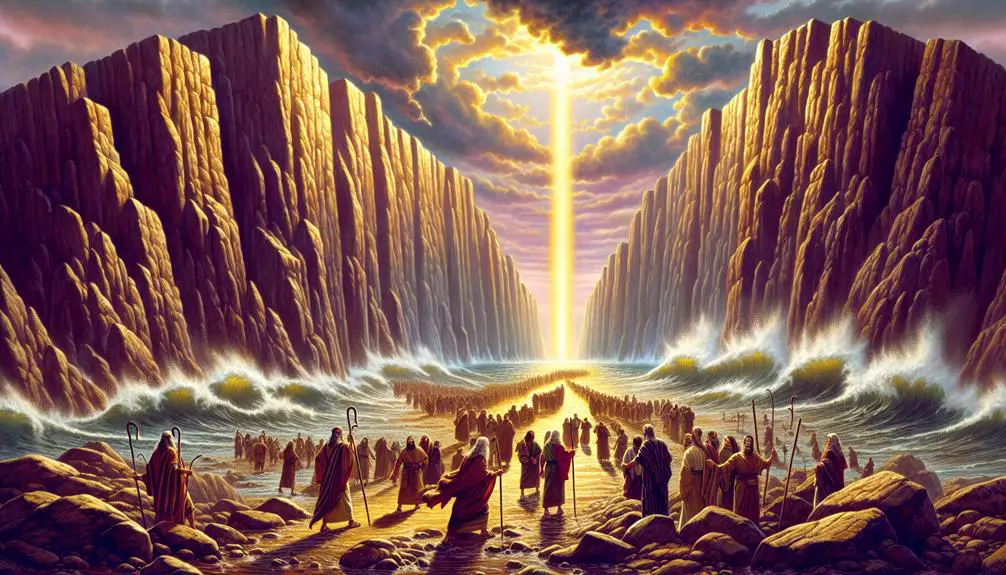
Deliverers in the Bible
Just as Hercules faced his twelve labors, the Bible presents its own heroes tasked with formidable challenges. You've probably heard of Moses, who led his people out of Egypt, but what about the others?
Deborah, Gideon, Samson, and Esther each played pivotal roles in their communities, overcoming oppressors and delivering their people from peril. Their stories aren't just ancient history; they're lessons in courage, faith, and determination.
As you explore these narratives, you'll find that each deliverer's journey offers unique insights into human nature and divine intervention. What might their experiences teach us about facing our own challenges today?
Key Takeaways
- Biblical deliverers exhibit diverse strengths, like leadership, strategic acumen, and physical might, tailored to their unique missions.
- Divine intervention and guidance play crucial roles in their victories, highlighting a partnership between human action and divine will.
- Their stories illustrate the importance of faith, courage, and wisdom in overcoming oppression and adversity.
- Each deliverer's approach to their mission—whether through warfare, strategic diplomacy, or sheer strength—underscores the multifaceted nature of leadership and deliverance.
Moses: Freedom From Egypt
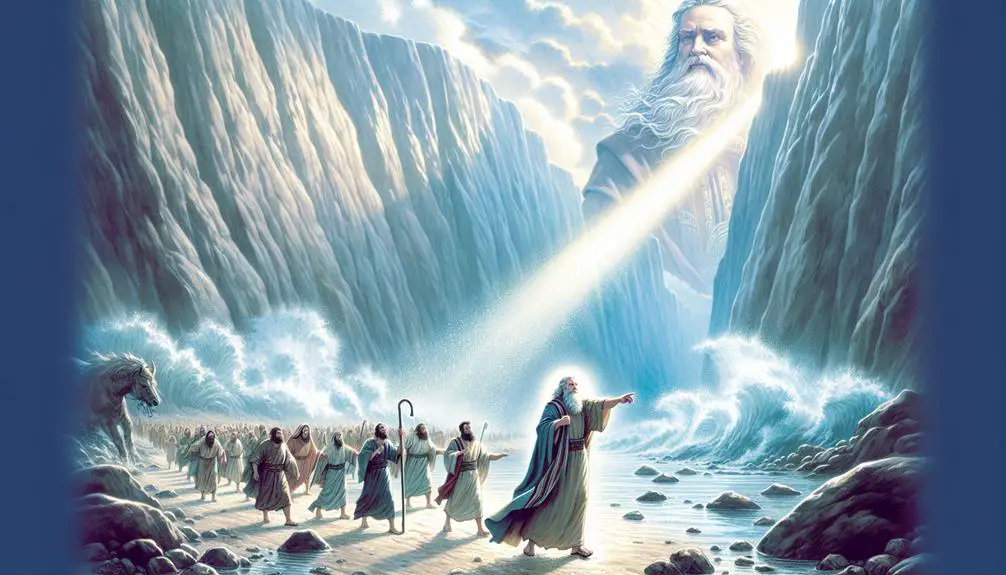
Moses frequently stands out as a pivotal figure in biblical history, leading the Israelites out of Egyptian bondage with unwavering determination and faith. His journey, as chronicled in the Exodus, is marked by the plague narratives, a series of divine interventions that underscore the struggle for freedom. You'll find that each plague, targeting the Egyptians' polytheistic beliefs, systematically dismantles the perceived invincibility of their gods, culminating in the liberation of the Israelite slaves.
The crossing of the Red Sea represents a climax in this narrative, not just as a miraculous event but as a symbol of irrevocable passage from slavery to freedom. This moment, where the waters part only to converge upon the pursuing Egyptian forces, serves as a powerful testament to divine protection and deliverance. It's here, in the analysis of these events, that you'll recognize the nuanced interplay between faith, leadership, and divine intervention.
Moses' role transcends that of a mere leader; he emerges as a deliverer, whose faith in the face of adversity sets a precedent for the Israelites' faith in God. Through the plague narratives and the crossing of the Red Sea, his journey encapsulates the essence of liberation and divine guidance.
Deborah: Victory in Canaan
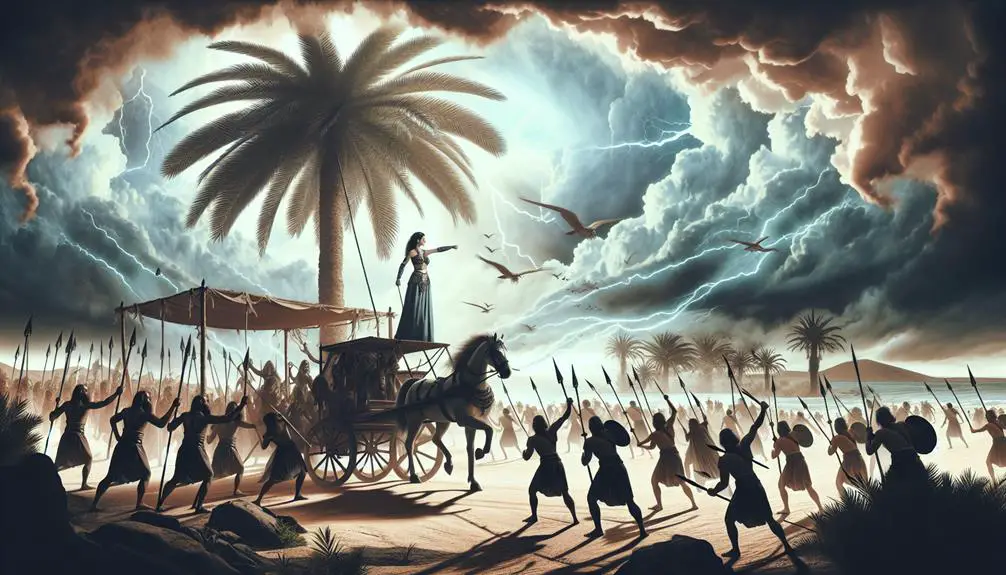
Shifting our focus to another epoch of biblical history, we encounter Deborah, whose leadership and strategic acumen led to a significant victory in Canaan. As a judge and prophetess, her role was pivotal in orchestrating the defeat of Jabin, the Canaanite king, and his commander, Sisera. This victory was largely attributed to Deborah's prophetic leadership and her ability to inspire and mobilize the Israelites against their oppressors.
Under Deborah's guidance, Barak's alliance with the tribes of Israel was a critical element in the battle strategy. Her foresight to bring together disparate tribes under a unified cause demonstrated her exceptional leadership qualities. Unlike other leaders of her time, Deborah's leadership wasn't just martial but also moral and spiritual. She provided a beacon of hope and a sense of direction for the Israelites, who were struggling under Canaanite domination.
Her story, immortalized in the Song of Deborah, highlights the importance of faith, courage, and unity in overcoming adversity. Deborah's victory in Canaan isn't just a tale of military triumph but a testament to the power of prophetic leadership and the pivotal role of women in biblical narratives.
Gideon: Overcoming Midian
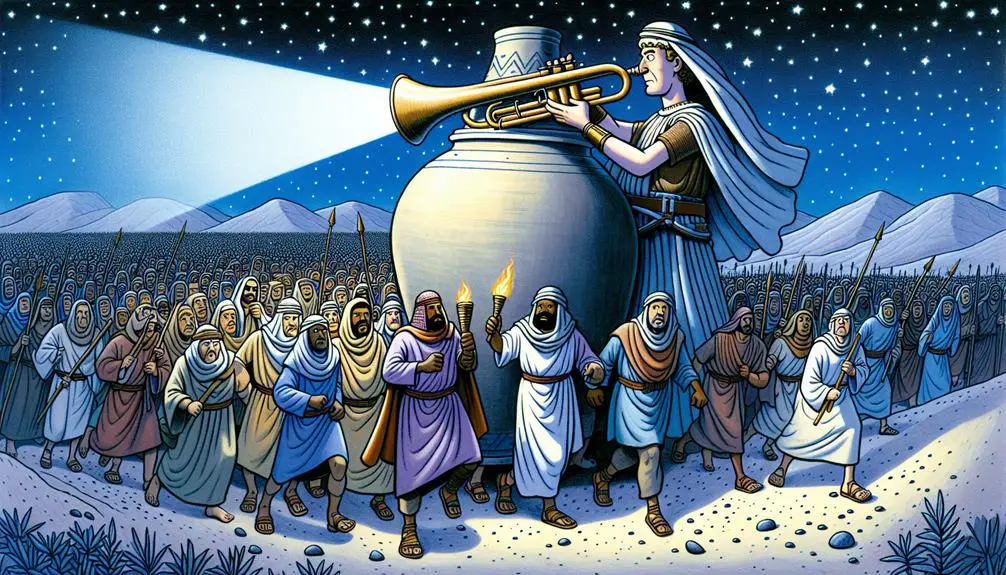
Transitioning from the era of Deborah's prophetic victory, we encounter Gideon, whose divine selection and strategic cunning were instrumental in overcoming the Midianite oppression. Gideon's story is pivotal, illustrating the intersection of divine guidance and human agency in the context of liberation. His narrative is marked by the fleece test, a method Gideon used to seek confirmation of God's will, showcasing his initial hesitance but ultimate faithfulness.
Gideon's military strategy, notably unconventional, emphasizes the power of psychological warfare and the element of surprise. With a significantly reduced force, he managed to confound and defeat the Midianites, a feat that underscored the principle that victory in battle does not solely depend on numerical strength but on strategic ingenuity and divine favor.
Aspect |
Description |
|---|---|
Fleece Test |
A divine sign requested by Gideon to confirm God's will, demonstrating his cautious faith. |
Military Strategy |
Gideon's use of a small force and psychological tactics to defeat a larger Midianite army. |
This account of Gideon not only contributes to the understanding of Israel's deliverance narratives but also offers insights into the dynamics of faith, leadership, and warfare in ancient contexts.
Samson: Strength Against Philistines
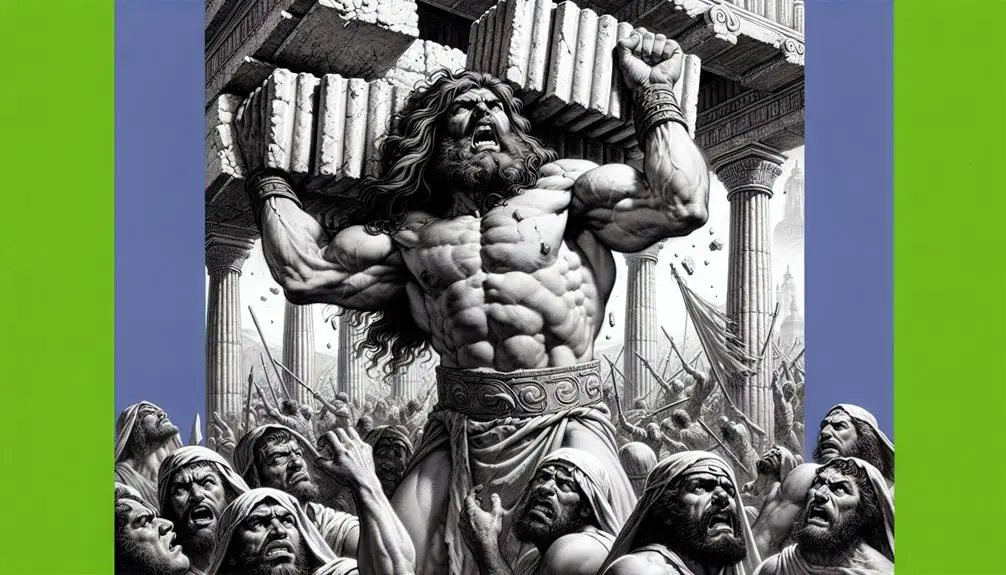
In the narrative of Israel's deliverance, Samson emerges as a pivotal figure whose extraordinary strength and tumultuous encounters with the Philistines highlight the complexities of divine empowerment and human frailty. His life, intricately woven with feats of unparalleled might, also unfolds a tale of vulnerabilities that ultimately lead to Samson's downfall. Central to understanding his journey is the Nazirite vow—a commitment to abstain from wine, avoid contact with the dead, and never cut his hair, symbolizing a life dedicated to God's service. This vow not only set Samson apart but also became the source of his strength.
Analyzing Samson's interactions with the Philistines reveals a cycle of provocation and retribution, shedding light on the Israelites' struggle for autonomy. His exploits, though heroic, often blur the lines between personal vendetta and divine mission, illustrating the tension between divine mandates and human actions. The narrative reaches its climax with the betrayal by Delilah, leading to the loss of his strength, imprisonment, and eventual death. However, even in his final act, Samson fulfills his role as a deliverer, demonstrating that strength and weakness can coexist, and that divine purposes can be accomplished through flawed individuals.
Esther: Saving the Jews
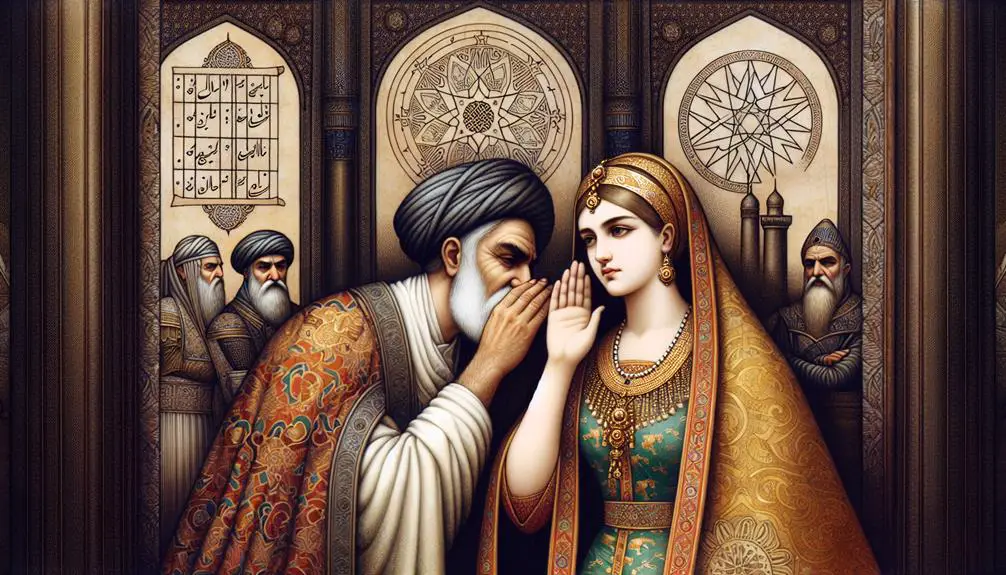
While Samson's story exemplifies the raw power of divine intervention, Esther's narrative unfolds a tale of strategic courage and wisdom, marking her pivotal role in saving the Jewish people from annihilation. Esther's intervention in the political machinations of the Persian court showcases a nuanced understanding of power dynamics and the importance of timing.
Here are four key aspects of Esther's story:
- Royal Banquets: Esther utilized these events not just as social gatherings but as strategic platforms for intervention. Her invitation to the king and Haman to attend the banquets was a calculated move to gain favor and set the stage for her plea.
- Persian Politics: Navigating through the intricate web of Persian politics required wisdom and discernment. Esther's approach to revealing Haman's plot was tactful, ensuring the king's receptiveness.
- Courageous Disclosure: Esther's revelation of her Jewish identity was a risk that brought the issue close to the king's heart, highlighting the personal stakes involved.
- Strategic Timing: Every action Esther took was meticulously timed, from her approach to the king to the revelation of Haman's plot, demonstrating her strategic acumen.
Esther's story is a profound example of how wisdom, courage, and strategic timing can overturn dire situations, showcasing the power of individual agency within the broader divine narrative.
Frequently Asked Questions
How Did the Concept of Deliverance Evolve Throughout the Old Testament, and How Does It Differ From New Testament Understandings?
You're exploring how the concept of deliverance shifted from the Old to the New Testament. Initially, it was closely tied to prophecy fulfillment and covenant significance, reflecting God's promises to His people.
Over time, this idea evolved. In the New Testament, deliverance took on a broader, more spiritual meaning, focusing on salvation through Jesus. This shift underscores the transformation from a physical to a spiritual understanding of being saved or delivered.
What Psychological and Spiritual Challenges Did These Deliverers Face, and How Did Their Personal Struggles Influence Their Leadership and Missions?
Facing psychological and spiritual challenges can deeply impact your leadership and mission. Personal growth often emerges from overcoming these struggles, shaping leadership styles in profound ways.
Analyzing such scenarios shows that leaders who confront their personal battles head-on tend to develop resilience and empathy, crucial for effective guidance. Their journey through hardship not only tests their resolve but also enriches their ability to lead and inspire others, marking their path with authenticity and strength.
How Did the Roles and Actions of These Deliverers Impact the Socio-Political Structures of Their Times, Beyond the Immediate Conflicts Described?
You're diving into how pivotal figures reshaped societies, focusing on their vast influence beyond mere disputes. Their roles catalyzed cultural integration and spurred economic reforms, weaving through the socio-political fabric of their times.
This wasn't just about winning battles; it was about rewriting the rules, shaping identities, and laying down new economic pathways. Their actions were a masterstroke in altering the power dynamics and fostering a legacy of transformation across generations.
In What Ways Did the Deliverance Provided by These Biblical Figures Inspire or Influence Other Religious or Historical Leaders Outside of the Jewish Tradition?
You're exploring how leadership and deliverance have transcended religious boundaries, sparking interfaith dialogues and serving as models for leaders across diverse traditions.
The actions and virtues of these figures haven't only shaped leadership models but also encouraged a deeper understanding and respect among different religious groups.
Their stories of courage, faith, and resilience continue to inspire leaders, motivating them to adopt similar values in their own leadership journeys.
How Have Modern Interpretations and Representations of These Deliverers in Art, Literature, and Media Deviated From or Stayed True to the Biblical Narratives?
You'll find that modern interpretations of these figures in art, literature, and media often take artistic license, diverging from the original narratives. Cultural adaptations play a significant role in how these stories are retold, reflecting contemporary values and perspectives.
While some versions stay close to the biblical accounts, others are markedly different, showcasing the creators' intentions to resonate with or challenge today's audiences, thus shaping the perception of these figures anew.
Conclusion
In conclusion, just as a single lighthouse guides countless ships through treacherous waters, these biblical deliverers have illuminated paths through oppression for their people. Whether it's Moses parting the Red Sea or Esther's strategic intervention, each story serves as a beacon of hope, showcasing resilience against overwhelming odds.
Analyzing these narratives reveals a universal truth: even in the darkest times, leadership, faith, and courage can usher in deliverance, transforming dire situations into tales of triumph.



Sign up